
About UsThe Numismatic Bibliomania Society is a non-profit organization promoting numismatic literature. For more information please see our web site at coinbooks.org SubscriptionsThose wishing to become new E-Sylum subscribers (or wishing to Unsubscribe) can go to the following web page link MembershipThere is a membership application available on the web site Membership Application To join, print the application and return it with your check to the address printed on the application. Membership is only $15 to addresses in the U.S., $20 for First Class mail, and $25 elsewhere. For those without web access, write to: David M. Sundman, Secretary/TreasurerNumismatic Bibliomania Society AsylumFor Asylum mailing address changes and other membership questions, contact David at this email address: dsundman@LittletonCoin.com SubmissionsTo submit items for publication in The E-Sylum, just Reply to this message, or write to the Editor at this address: whomren@coinlibrary.com BUY THE BOOK BEFORE THE COINYou won't regret it! |
- WAYNE'S WORDS: THE E-SYLUM APRIL 25, 2010
- THE STACK FAMILY NUMISMATIC LIBRARY PART II
- SKLOW LITERATURE AUCTION SALE #10 NOW ONLINE
- KARL MOULTON'S SPRING/SUMMER 2010 LITERATURE PRICE LIST
- LAKE BOOKS NUMISMATIC LITERATURE SALE #102 PRL AVAILABLE
- NEW BOOK: THE GALATA GUIDE TO MEDIEVAL HALF GROATS
- MORE ON THE WILLIAM A. BURD NUMISMATIC LIBRARY
- DICK JOHNSON: WHY ANOTHER NUMISMATIC ENCYCLOPEDIA?
- ANS LIBRARY CATALOG NAMING CONTEST WINNER ANNOUNCED
- ON THE KRAUSE PUBLICATIONS NUMISMATIC LIBRARY
- THE PAPERS OF CHIEF ENGRAVER CHARLES EDWARD BARBER
- MORE ON COIN CLUB MEETING REPORTS
- ROBERT SCOT & THE DRAPED BUST DESIGN
- FRANK DUPEE FOUND IN NEW HAVEN, CONNECTICUT
- THE 1942/41 OVERDATE DIMES: NOT DOUBLED DIES
- WHO PASSED THE BBC NEWS NUMISMATIC QUIZ?
- NOTES FROM E-SYLUM READERS: APRIL 25, 2010
- QUERY: PAPER MONEY REPAIRS
- THE 2010 BROOKGREEN GARDENS MEMBERSHIP MEDAL
- THE HOWARD BOWKER CHINESE COIN COLLECTION
- NEW 2011 $100 BILL DESIGN UNVEILED
- MONEY MAKEOVERS: ARE THE DEAD PRESIDENTS GETTING YOUNGER?
- ROBERT LEUVER ON THE ANA ROSEMONT CONVENTION SITE
- JOE BOLING ON THE ANS COUNTERFEIT MONEY EXHIBIT
- ON JANVIER REDUCING MACHINES
- EGYPT FINDS HOARD OF 2,000-YEAR-OLD BRONZE COINS
- VICTORIA CROSS MEDAL SELLS FOR A RECORD £252,000
- MAN ARRESTED IN ENGLAND FOR USING NORTHERN IRISH BANKNOTE
- FEATURED WEB SITE: AMERICAN MEDALLIC SCULPTURE ASSOCIATION
WAYNE'S WORDS: THE E-SYLUM APRIL 25, 2010

Among our new subscribers this week is Doug Herbert. Welcome aboard! We now have 1,334 subscribers.
This week we open with announcements from FOUR numismatic literature dealers, followed by word of a new book on Medieval Half Groats.
Other topics include Numismatic Encyclopedias, the ANS Library Catalog, the Krause Publications numismatic library, and the papers of Chief Engraver Charles Edward Barber.
To learn about an upcoming biography of Robert Scot, the location of Frank Dupee's coin and stamp shop, KP Duty, Mrs. D. Dee DeNise and how dead Presidents manage to look younger, read on. Have a great week, everyone!
Wayne Homren
Numismatic Bibliomania Society
THE STACK FAMILY NUMISMATIC LIBRARY PART II
On June 3rd, 2010, Kolbe & Fanning Numismatic Booksellers will offer for sale at auction the second part of the remarkable numismatic library carefully assembled over seven decades by the New York numismatic firm founded by brothers Morton and Joseph and ably carried on by Norman, Benjamin, Harvey, Susan, and Lawrence Stack.
For over fifty years, the fabled American portion of the library resided in antique bookcases lining one wall of Harvey Stack's office, and along the opposite wall as well. Other portions of the library were, for many years, located throughout the main floor of the firm's New York City retail location at 123 West 57th Street and many of the great classic works on ancient and foreign coins and medals were carefully arranged on the second floor in the Coin Galleries offices. Covering virtually all aspects of numismatics and replete with rarities, it was one of the finest working libraries on numismatics ever formed in the United States.
On January 9, 2010, 400 lots of key works from this magnificent library were sold by George Frederick Kolbe at the Waldorf Astoria Hotel in New York City in conjunction with the New York International Numismatic Convention. The total price realized, including the 15% buyer premium, was nearly $950,000, or an average of nearly $2,400 per lot. Added to that were 100 lots of duplicates from the American Numismatic Society Library, bringing the sale's grand total to slightly over one million dollars.
Comprising 1072 lots, this upcoming second Stack's sale is particularly rich in often-consulted standard reference works, although it also includes a number of rarities and particularly desirable items that did not find their way into the first sale. Highlights among the 506 American lots in the June 3 sale include:
- Stack's 1930s Ledger and Daybook featuring accounting Information for their first auction;
- Coin Galleries's special hardbound set of Stack's auction sales, essentially complete from 1935 into the 1970s;
- the firm's soft-cover set of Stack's Fixed Price Lists;
- an original 1894 American Numismatic Association Convention Program, one of only three known;
- several photocopy sets of The Barber Papers, a most important archive comprising personal and professional papers from U.S. Mint Chief Engraver (1879-1917) Charles E. Barber [the originals were donated to the Smithsonian Institution by the Stack Family some years ago];
- a number of American counterfeit detectors, including Heaths;
- a number of seldom-offered early ANA Convention auction sales;
- a bound volume of George L. Leavitt coin auction sales including two unlisted in Gengerke;
- a collection of Stack's office copies of B. Max Mehl auction catalogues;
- a complete set of Lester Merkin catalogues;
- Harvey Stack's heavily annotated 1959 Pennypacker Sale featuring Leonard Holland's choice large cent collection;
- Wayte Raymond's earliest known numismatic publication;
- an inventory and appraisal of the Byron Reed Collection;
- Stack's office copy of the famous Brobston price list of half cents, featuring buyers' names;
- a great many bound special edition Stack's sales, some rarely offered;
- and many more American numismatic works of exceptional interest.
The second half of the sale is largely comprised of still indispensable works on ancient, medieval and modern numismatics covering the international numismatic spectrum. A few works featured among them include:
- important references on Renaissance medals;
- classic European auction sales of ancient Greek and Roman coins;
- a beautifully bound original set of Dalton & Hamer's Provincial Token-Coinage of the 18th Century;
- Dattari's own heavily annotated set of Monete Imperiali Greche, still the classic work on the coins of Roman Egypt;
- a complete set of American Numismatic Society Museum Notes and a nearly complete set of Numismatic Notes and Monographs;
- Graham Pollard's own set of Italian Renaissance Medals in the Museo Nazionale of Bargello;
- Salvesen's 1987 Trade Dollars & Trade Coinage of the World, one of only 15 copies issued;
- and a run of various Sylloge Nummorum Graecorum fascicules.
Printed copies of the upcoming June 3, 2010 sale catalogue may be obtained by sending $10.00 to Kolbe & Fanning Numismatic Booksellers, 141 W. Johnstown Road, Gahanna, OH 43230-2700. Telephone: (614) 414-0855; Fax: (614) 414-0860; Email: df@numislit.com. The catalogue is also accessible free of charge at the firm's web site: www.numislit.com .
SKLOW LITERATURE AUCTION SALE #10 NOW ONLINE
NUMISMATIC LITERATURE AUCTION SALE # 10 CATALOG IS ONLINE!
June 12, 2010, David Sklow - Fine Numismatic Books will close their 10th auction.
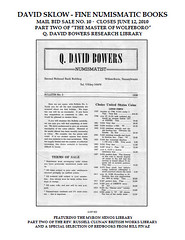 Catalogs available by request at no
charge; Send inquiries to: David Sklow-Fine Numismatic Books, P. O. Box 6321, Colorado Springs, CO 80934. Telephone: (719)-302-5686; Fax: (719)-302-4933; Email:
numismaticbooks@aol.com. The catalog is currently accessible on-line: www.finenumismaticbooks.com Bids will be accepted by, telephone, fax, email and regular mail.
Catalogs available by request at no
charge; Send inquiries to: David Sklow-Fine Numismatic Books, P. O. Box 6321, Colorado Springs, CO 80934. Telephone: (719)-302-5686; Fax: (719)-302-4933; Email:
numismaticbooks@aol.com. The catalog is currently accessible on-line: www.finenumismaticbooks.com Bids will be accepted by, telephone, fax, email and regular mail.
Several sale highlights: Part Two of The Q. David Bowers Research and Source Library; Selections from the Personal Library of Myron Xenos; Part Two of the Rev. Russell Clunan Library of British Works; The Special Red Books of Bill Fivaz; Several other fine Consignments:
Closes June 12, 2010
- Over 250 works concerning the California Gold Rush, The West, Mining.
- The Rare Catalogue of Henry H. Clifford's California Pictorial Letter Sheets.
- The Cripple Creek Strike, by Emma F. Langdon.
- Several Rare Volumes by Nollie Mumey.
- Unique Letter by Walter Breen to Q. David Bowers.
- The Complete 22 Volume 1832 First American Edition of the Edinburgh Encyclopedia, with Numismatic Plates.
- Deluxe Interleaved 1909 Premium List of U.S. Private and Territorial Gold, by Adams.
- First Edition 1842 Eckfeldt & Du Bois, Manual of Gold & Silver Coins.
- 1929 First edition The Bechtlers and Bechtler Coinage, by Clarence Griffin.
- Deluxe Leather Edition of Private Gold Coins 1931, by Wayte Raymond.
- Long Run of the British Numismatic Journal.
- Long Run of Seaby's Coins and Medal Bulletin.
- Rare Supplements to the Spink Numismatic Circular 1896-1911 ex: Ken Lowe.
- Long Run of the Spink Numismatic Circular.
- Complete Set of the Richard Cyril Lockett Collection Sale Catalogs by Glendining.
- Long Runs of British Standard Reference Works.
- Beautiful Complete Volume III [in original paper covers] of the American Journal of Numismatics 1868-1869, with the Levick 1793 Cent Plate and First U.S. Mint Plate.
- The Asylum Volumes 1-10, by NBS.
- Long Run [some rare] of Reprints from the Numismatic Scrapbook.
- 1910 Auction Catalog of the American Numismatic Association Convention Sale in New York City, by Daniel Kennedy.
- Long Run of 19th Century Auction Catalogs, some priced, several not listed in Adams or Gengerke.
- Long Run of William Elliot Woodward Auction Catalogs.
- Long Run of Early Fixed Price Lists, including, Chapman, Frossard, Low and Steigerwalt.
- The Unique Planning Sheets for The Invasion of Louisville, by Armand Champa 1988.
- Cal Wilson's Appraisal of the Armand Champa Library 1985.
- The Red Books of Bill Fivaz
- Run of Deluxe Auction Sales of George Frederick Kolbe, Including Leather
- Examples of the John Ford Catalogs.
- Deluxe Leather Numbered 25 of 25 Edition of David Lange's Complete Guide to Buffalo Nickels.
- Editors Proof of The CherryPickers Guide, Fourth Edition.
- Numismatic Bulletin No. 2 by Q. David Bowers, 1956. [The Catalog Front Cover].
- Penn-New York Auction Co. Sale July 29, 1957. [QDB & JFR].
- Triple Cities Coin Exchange Catalog July 1956 by James F. Ruddy [before QDB joined him].
- Deluxe Morocco Edition of Adams, Private Gold Coinage of California, 1913.
………See our web site for the online catalog!
Consignments are now being accepted for all future sales.
David Sklow-Fine Numismatic Books
P.O. Box 6321
Colorado Springs, CO 80934
PH: 719-302-5686
FAX: 719-302-4933
EMAIL: numismaticbooks@aol.com
WEB: FineNumismaticBooks.com
KARL MOULTON'S SPRING/SUMMER 2010 LITERATURE PRICE LIST
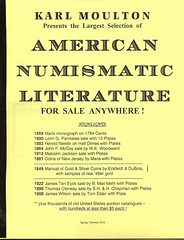 Offered for sale
are hundreds of items ranging from $4 to $6950. Among the selected rarities can be found an 1869 Edward Maris on 1794 Large Cents monograph (one of less than 20), a plated 1890
Thomas Cleneay sale by S H & H Chapman (one of less than 30), an 1883 plated Harold Newlin on Half Dimes (one of less than 20), a 1913 Deluxe Malcolm Jackson sale with plates (one
of less than 15), and an 1849 Eckfeldt & DuBois Manual of Gold and Silver coins with real '49er gold samples on p.235 (one of less than 10).
Offered for sale
are hundreds of items ranging from $4 to $6950. Among the selected rarities can be found an 1869 Edward Maris on 1794 Large Cents monograph (one of less than 20), a plated 1890
Thomas Cleneay sale by S H & H Chapman (one of less than 30), an 1883 plated Harold Newlin on Half Dimes (one of less than 20), a 1913 Deluxe Malcolm Jackson sale with plates (one
of less than 15), and an 1849 Eckfeldt & DuBois Manual of Gold and Silver coins with real '49er gold samples on p.235 (one of less than 10).
If these were coin items, with the extant numbers known, they would all be at least 10 times higher priced, but since they are literature items that relate to numismatics, at present levels, they represent one of the very best investments in the entire coin hobby (not to mention the benefit of gaining knowledge).
Numerous American auction catalogues, beginning in the 1860's to the present time, are offered at reasonable prices. Complete sets of Bowers catalogues are offered, along with other reference materials such as the American Journal of Numismatics, The Numismatist, and Roger Burdette's 3 volume set of 20th century Renaissance of American Coinage books. All of the major auction companies are represented, and the information found in the catalogues helps track pedigrees and other offerings.
There's something for everyone! An updated list, with hundreds of prices realized (not printed in the list) will be available online next week at www.coincats.com .
LAKE BOOKS NUMISMATIC LITERATURE SALE #102 PRL AVAILABLE
The prices realized list for our sale #102 of numismatic literature is now posted to our web site at: http://www.lakebooks.com/current.html
This was an active sale, particularly in the area of "Redbooks", "Bluebooks", and the Wayte Raymond "Coin Collector Journals". Another section that saw spirited bidding was Steve Ivy's "Legacy" magazine with their marvelous interviews.
Our next sale will be held in June, 2010 and we are always interested in consignments for this and future sales. Please contact us for more information.
Lake Books
6822 22nd Ave. N.
St. Petersburg, FL 33710
727-343-8055 Fax 727-345-3750
www.lakebooks.com
NEW BOOK: THE GALATA GUIDE TO MEDIEVAL HALF GROATS
 This is to inform you of the
publication of a new numismatic book : The Galata Guide to MEDIEVAL HALF GROATS by D I Greenhalgh. This was launched at the British Association of Numismatic Societies Congress at
Cambridge on Saturday 10th April, where one of the books was donated by the publishers and the author as a raffle prize in aid of the Association. After that, delegates who had
been unsuccessful in the raffle, were able to purchase a copy by the usual means, and the author was signing them.
This is to inform you of the
publication of a new numismatic book : The Galata Guide to MEDIEVAL HALF GROATS by D I Greenhalgh. This was launched at the British Association of Numismatic Societies Congress at
Cambridge on Saturday 10th April, where one of the books was donated by the publishers and the author as a raffle prize in aid of the Association. After that, delegates who had
been unsuccessful in the raffle, were able to purchase a copy by the usual means, and the author was signing them.
The book is the third in the expanding Galata Guide series, which offers the best and latest in the way of scholarship on a diverse series of numismatic subjects. In this instance, the author, who is undoubtedly the leading authority and collector of English halfgroats of the medieval period has been collecting and studying the coins for 30 years.
The research for this guide involved him travelling to over 130 museums throughout the UK and the rest of Europe to study, record and photograph their holdings of relevant coins. He was also privileged to view important private and trade collections which were not normally available to view.
The Guide records numerous previously unrecorded types and varieties. There are over 1000 images life-sized and enlarged alongside over 500 photo-illustrations to produce as good an illustration as is possible. Computer enhancement techniques have been used to profile the salient points of variations to enable easier identification.
This work is already receiving acclaim by numismatists as being the definitive guide to medieval halfgroats.
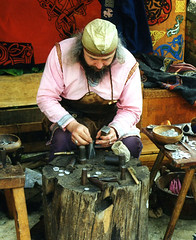 Some people
will know the author better as Grunal, or Dave the Moneyer from his appearances as a moneyer in full kit, making coins at the Tower of London, the British Museum, or a dozen and
one other places.
Some people
will know the author better as Grunal, or Dave the Moneyer from his appearances as a moneyer in full kit, making coins at the Tower of London, the British Museum, or a dozen and
one other places.
The book is A4, has 174 pages, and is PB, with laminated card covers. The cover blurb says that it is :
- The definitive guide to medieval half groats.
- Useful for all collectors from the absolute beginner to the most advanced.
- Illustrated with enlarged photographs for easy recognition.
- Important identification points highlighted by photo illustrations taken from the actual coins.
- Previously unpublished types and varieties are included.
- The Mints covered are: London, Bristol, Calais, Canterbury, Coventry, Norwich and York.
- Includes a concordance with all major reference works relating to half groats.
- Includes forgeries, alterations, reproductions and electrotypes.
- Includes a handy roadmap to the identification of types.
- Essential for the archaeologist, collector, metal detector user, and museum curator.
£45 incl UK postage. (US 80$) incl. airmail postage.
What the blurb doesn't say is that the book is only available directly from the publisher. However, directly we had sent information to the ISBN system, the information was lifted by various folk all over the world and it was apparently available not only available via Amazon, but in almost all major bookstores throughout the UK, and in many minor ones too, not to mention in such places as far away as Norway, The Netherlands, and Japan.
And all this before the book was actually printed ! Not only that, but some of the people had lifted the cover illustration to go with the book details. Such is modern marketing by those who like to make an unwarranted and undeserved profit from the labour of other people, all without very much cost or effort to themselves ! So, despite what you see on the web it is ONLY available from GALATA. For more details of the book and the author see www.galata.co.uk and double-click on "Click here for details of new publications"
MORE ON THE WILLIAM A. BURD NUMISMATIC LIBRARY
Ragarding the William A. Burd Numismatic Library, Tom DeLorey writes:
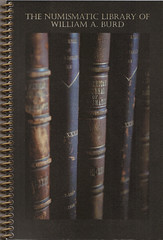 Bill Burd's Chicago Coin Company
is not located in downtown Chicago. It is a little over a mile west of the northwest corner of Midway airport.
Bill Burd's Chicago Coin Company
is not located in downtown Chicago. It is a little over a mile west of the northwest corner of Midway airport.
My wife and I attended Bill's open house. The library really is quite wonderful! While browsing the shelves, I could not resist taking down his copy of the Coin World Comprehensive Catalogue & Encyclopedia and signing it above my name, dating it with the date of his open house. I then apologized for decreasing the value of the book!
THE MINTING EQUIPMENT BAZARRE

DICK JOHNSON: WHY ANOTHER NUMISMATIC ENCYCLOPEDIA?
I sincerely appreciate Bruce W. Smith writing and listing 12 numismatic encyclopedias in last week's E-Sylum. Was his implication: Do we need another numismatic encyclopedia?
I was aware of these, of course. In fact I list 46 numismatic dictionaries and encyclopedias in by bibliography and have consulted most of these. This in addition to dozens and dozens of glossaries. Plus reading and working in the field for fifty years.
What Bruce overlooked, perhaps, was the last word in the name "Encyclopedia of Coin and Medal Technology." My encyclopedia contains entries on the Technology of the field -- how coins and medals are designed, made, collected, cataloged and curated.
What existing numismatic encyclopedias, including Bruce's simplistic list of 12, concentrate on are coin names and denominations. Albert Frey's classic work, for example, contains 4,111 terms, with an extremely high percentage of these coin names. In fact, the last word is in his title, "Dictionary of Numismatic Names."
A work I have found most exhaustive is in German, "Worterbuch der Munzkunde" edited by Fredrich von Schroetter, with the help of five contributors, published in 1930 (reprinted by Argonaut 1970). I had two copies in my library. I say "had" as I lent one copy to Walter Breen. I have mentioned this in The E-Sylum before (vol 10, no 18, art 16) because the book is distinctive in a red binding. My other copy is in paper binding, as issued, still on my shelf.
You won't find 4,111 names in my encyclopedia. I cover the field from a technical direction. I define and explain the terms coin and medal makers use. These often differ from those used by numismatists and collectors. For example medal makers call "insert die" for a supplemental part of a die used to create raised lettering to customize a long run of medals. Collectors were calling this a "compound die" -- among other mistaken terms -- without the knowledge of correct Technical Term.
My encyclopedia will be different from all others. I am not plowing the same ground as all those other dictionary and encyclopedia writers. My encyclopedia will answer technical questions, like "how did they do that, and what do they call it?"
To read the earlier E-Sylum article, see: ON NUMISMATIC ENCYCLOPEDIAS (www.coinbooks.org/esylum_v13n16a11.html)
ANS LIBRARY CATALOG NAMING CONTEST WINNER ANNOUNCED
The winner of the Library Catalog Naming Contest has been decided! The chosen submission was given by Andrew G. Scott, Assistant Professor of Classics at Hendrix College in Arizona. Andrew was a recent participant in the ANS Summer Seminar in Numismatics during 2009. Well done, Andrew! And thank you again to all who entered. We had some fantastic entries overall.
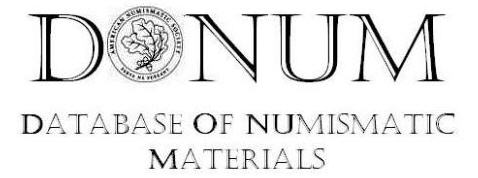
The new catalog will be called DONUM. This is short for Database of NUmismatic Materials. The word "donum" is also Latin for "gift", and as a free resource, this online catalog is our gift to the world. The new online catalog is still very much being developed and we thank you in advance for your patience. A trial version of the new catalog is available at present at the following: http://donum.numismatics.org/ .
While the catalog has been updated to contain even the most recently cataloged items, we are still working out a number of technical issues associated with making searches more efficient. Updates about this ongoing progress will be forthcoming.
To read the earlier E-Sylum article, see: ANS LIBRARY CATALOG NAMING CONTEST RESULTS TO BE UNVEILED (www.coinbooks.org/esylum_v13n16a07.html)
ON THE KRAUSE PUBLICATIONS NUMISMATIC LIBRARY
Regarding Bruce Smith's mention of the Krause Publications numismatic library, David Ganz writes:
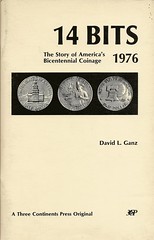 Rollie Finner wasn't the only person who
used the Krause Publications library late at night and on weekends. During my tour of KP Duty, May 1973 (after graduating from Georgetown's Foreign Service School) to Jan 1974
(when I entered law school in New York), when I was assistant editor of Numismatic News, I spent a lot of time in the library.
Rollie Finner wasn't the only person who
used the Krause Publications library late at night and on weekends. During my tour of KP Duty, May 1973 (after graduating from Georgetown's Foreign Service School) to Jan 1974
(when I entered law school in New York), when I was assistant editor of Numismatic News, I spent a lot of time in the library.
I was reading old minutes of the Bicentennial coin & medal advisory panel on which Cliff Mishler served, and put together the annotated version of America's Bicentennial Coin Story which was published in The Numismatist from March to June, 1975.
I spent hundreds of hours there, the footnotes of which (more than 500) remain an exhaustive study of that whole process. The article was later updated and published in book form as 14 bits by Three Continents Press in Washington. The book included a number of Congressional documents which complete the tale of America's bicentennial coinage.
My researching days at Krause were great numismatic fun because of the breadth of the library.
To read the earlier E-Sylum article, see: AN OVERLOOKED RESOURCE: COIN CLUB MEETING REPORTS (www.coinbooks.org/esylum_v13n16a16.html)
THE PAPERS OF CHIEF ENGRAVER CHARLES EDWARD BARBER
George Kolbe writes:
David L. Ganz and the American Numismatic Association have graciously granted permission to access David's excellent in-depth 1995 Numismatist article on "The Barber Papers," photocopies of which are to be sold as lot 41 et seq. in Kolbe & Fanning's June 3, 2010 auction sale of the second part of the Stack Family Library. A link to the article will be found at www.numislit.com
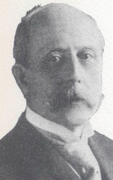 Charles Edward Barber, chief
engraver of the United States from 1879 until 1917, was an extraordinary artist, and in a half century career at the United States Mint that began during the administration of
President Andrew Johnson, and ended while Woodrow Wilson was president, he probably designed, and engraved, more coins and medals than any other person in the employ of the United
States, before or since.
Charles Edward Barber, chief
engraver of the United States from 1879 until 1917, was an extraordinary artist, and in a half century career at the United States Mint that began during the administration of
President Andrew Johnson, and ended while Woodrow Wilson was president, he probably designed, and engraved, more coins and medals than any other person in the employ of the United
States, before or since.
Minting facilities around the world began to produce his designs in 1869, the year he was apprenticed to his father, William Barber, then chief engraver of the United States at the Philadelphia Mint. Almost a century later, some of his designs were still being coined, a tribute to his talent as a designer, engraver and artist.
If this were all that Charles Barber had accomplished, he would have been considered an extraordinary, prolific artist and a talented designer. But he was also a chronicler of his life and times, an inveterate saver of correspondence received and copies of letters sent by him. And, he was also a collector who saved examples of the coins that he created, and the patterns that he designed -- together with examples of the work of others.
In November, 1991, the Library and Museum of the American Numismatic Association received an extraordinary gift from Harvey, Norman and Lawrence Stack: copies of the personal papers of Charles Barber, covering his term as sixth chief engraver of the United States Mint at Philadelphia. The originals were deposited at the Smithsonian Institution, but a complete set of the papers (which are about three inches thick) was presented to the ANA Library with the caveat that they could not be written about by scholars, or others, for a period of three years, to give the Smithsonian Institution time to examine this important find.
Organized by category, the papers cover coinage of the United States and many foreign countries, medallic works by the artist, and his extraordinary collection of numismatic pattern pieces, which was one of the finest ever assembled. They are now available for use in the ANA library, and copies may be loaned to interested members.
Barber's papers include handwritten correspondence, typescripts, and many design sketches for various coins. This article briefly summarizes some of the interesting finds in the personal papers of Charles Barber, and points out areas
MORE ON COIN CLUB MEETING REPORTS
David W. Lange writes:
To follow up on Bruce W. Smith's observation about coin club reports being useful in numismatic research, I can confirm that these can make for some interesting reading. I read through all of the meeting minutes for the Pacific Coast Numismatic Society dating back to its founding in 1915 as the host city for that year's ANA convention.
I compared what I found within the minutes with what was reported in the club's monthly bulletins to get a broader picture of both the numismatics and politics that transpired. This information, combined with my general knowledge of the hobby's history during that time frame, was incorporated into my history of the society, which ran serially in The Journal of the Pacific Coast Numismatic Society about twenty years ago. Some of what I learned was not flattering to certain individuals who were either still living or were well remembered by current members, so I decided to end the series of articles at about the year 1950.
It was also fun to read about the interaction with the society of prominent figures such as Abe Kosoff and the Stacks. Particularly of interest to students of ANA history was the correspondence relating to the 1949 ANA convention in San Francisco. Since it had been unsuccessful in persuading the ANA to come to San Francisco during the 1930s, the PCNS had sponsored a series of regional conventions which were called, I believe, the Far Western Numismatic Conference (I don't have my PCNS Journals handy). These ran 1933-39 and were the brainchild of Ernest Wernstom, whose untimely death in 1938 was largely responsible for their demise.
The ANA finally relented for the centennial of the California Gold Rush in 1949, but it evidently deemed the resulting convention a miserable failure. Of course, both the hobby and the nation were in a recession that year, but SF and its numismatic leaders were considered the culprits by the mostly eastern or mid-western ANA establishment. This led to repeated refusals to go back to the city throughout the 1960s by board members who recalled the debacle, and particularly frustrating was the failure of PCNS to host the ANA convention on its 50th anniversary in 1965. Indeed, the ANA didn't return to San Francisco until 2005, and then it was only because its original destination, San Jose, announced that it was holding an Indy car race the same week. It turned out to be a moderately successful event, though lacking the attendance of most eastern conventions.
To read the complete article, see: AN OVERLOOKED RESOURCE: COIN CLUB MEETING REPORTS (www.coinbooks.org/esylum_v13n16a16.html)
ROBERT SCOT & THE DRAPED BUST DESIGN
The recent discussion initiated by Jim Wells on the Draped Bust design has been very interesting. I have been researching Robert Scot for several years and am in the process of writing a biography on Scot. The book will include many illustrations and a register of more than 250 individual engravings by Scot, in addition to his work for the United States Mint. All sources will be fully referenced. Scot's engraving was very much in demand, at times he worked seven days a week. Scot also trained many apprentices and assistants who went on to become prominent engravers of their own firms. Thomas Jefferson assessed Scot's engraving on October 21, 1780, stating "The workmanship was extraordinarily good."
This is an example of an original Scot copperplate engraving from my collection, both engraved and printed by Scot in 1791, The Motion of Venus and Mercury in respect to the Earth. Having been trained in technical drawing, I appreciate the high degree of skill needed to create this engraving using 18th century tools:

 Drapery designs were described and then
illustrated by Robert Scot before his appointment to the Mint, similar to the draperies used on the Draped Bust coin design, "The drapery must not fit too close to the parts
of the body: but let it seem to flow round, and as if it were to embrace them; yet so as that the figure may be easy" etc. Also included on some illustrations was a clasp or
"ornament" similar to John Reich's engraving of the Capped Bust design. This information along with pictures and references will be included in my book. These are
the probable source of the Draped Bust design, using draperies of classic Greek origin, not contemporaneous American fashion.
Drapery designs were described and then
illustrated by Robert Scot before his appointment to the Mint, similar to the draperies used on the Draped Bust coin design, "The drapery must not fit too close to the parts
of the body: but let it seem to flow round, and as if it were to embrace them; yet so as that the figure may be easy" etc. Also included on some illustrations was a clasp or
"ornament" similar to John Reich's engraving of the Capped Bust design. This information along with pictures and references will be included in my book. These are
the probable source of the Draped Bust design, using draperies of classic Greek origin, not contemporaneous American fashion.
Gilbert Stuart did not use this style of drapery in portraits of Anne Bingham. A Stuart family relative informed John Ross Snowden that Gilbert Stuart provided a drawing used for the Draped Bust coinage. The information given to Snowden was more than a generation after the fact from an unidentified relative, with no recorded mentioning of Anne Bingham. I concur with the opinion of R. W. Julian given on 4/11/2010, "the chances of Anne Willing Bingham's portrait having been used for the coinage are slight at best." Without contemporary documentation, it remains a myth that should not be stated as fact.
As an addition to the discussion on John Eckstein, he was also listed in Browere's Life Masks of Great Americans, Charles Henry Hart, 1899. John Eckstein was included as one of the few late eighteenth century artists from the United States who created models ("modelling") using plaster, although his work was described as "of mediocre ability." I believe Eckstein's "models" were as stated - models by a person known to create models using plaster, to be used as reference for the important Draped Bust and Small Eagle design change. For the new design, Robert Scot would need considerable time to create all of the new master hubs for the many denominations of the Draped Bust.
This was a remarkable accomplishment as Scot had engraved dies for ten denominations by 1796, with assistance from John Smith Gardner. The February 1795 Mint job description for Engraver indicated the terminology used for the hubs and dies and does not include the word "model": "The Engraver, whose actual duties are the raising and furnishing all punches that are requisite for completion of the dies, the engraving and sinking all original dies, and raising all hubs that are struck out of them. He has an assistant, occasionally, as the business is urgent."
Karl Moulton made this statement on 4/18/2010, "In the 18th and 19th centuries, engravers did not have to work at, or be at, the Mint. This is evidenced by Scot having John Reich work on dies 'for the national coin' several years before he was appointed as the assistant engraver in April of 1807. This is brought out in the 1884 three volume set titled, 'The History of Philadelphia' by Scharfe and Westcott."
The quotation in the Scharf and Westcott book did not state that Reich engraved coinage dies several years prior to 1807. The complete sentence from page 1064 reads, "John Reich, of whom Dunlap says that he was 'the best artist in his line that Philadelphia had had,' was a die-sinker, frequently employed by Robert Scot, the engraver of the United States Mint, to prepare the dies for the national coin."
The paragraph goes on to describe medals, not coinage dies, engraved by Reich before his employment with the US Mint in 1807. William Dunlap was used as a reference, in his 1834 work History Of The Rise And Progress Of The Arts Of Design In The United States he gave hundreds of brief biographies of early American artists. While Dunlap's book is a good historical reference, there are many errors in the details including Robert Scot's description.
To read the earlier E-Sylum article, see: KARL MOULTON ON JOHN ECKSTEIN, ENGRAVER (www.coinbooks.org/esylum_v13n16a09.html)
FRANK DUPEE FOUND IN NEW HAVEN, CONNECTICUT
Walt Weigand writes:
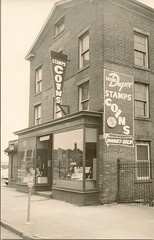 Using online genealogical
resources, I locate a Frank H. Dupee under "Numismatists" in a circa 1950 directory. His business address is listed as 204 George St, New Haven, CT [downtown area]. This
would corroborate Jud Petrie's recollection.
Using online genealogical
resources, I locate a Frank H. Dupee under "Numismatists" in a circa 1950 directory. His business address is listed as 204 George St, New Haven, CT [downtown area]. This
would corroborate Jud Petrie's recollection.
Comments from readers suggested that New Haven and 1950-ish sounded like the most promising leads. The Ancestry.com website has a 1950 Census Substitute search available to subscribers. It makes use of City Directories from the mid-1940's thru the 1950's. For non-subscribers, it permits searches but teases you with only partial views of the "hits". I'm not a subscriber, but searched "Frank" "Dupee" "New Haven" anyway.
Among the "hits" was one headed "Numismatists" which included Frank H. Dupee, 204 Geo[rge St] and 2 other dealers. Ancestry does not include enough of the original page image to see the date or directory name. There are other "hits" from which one can speculate on his other business activities, home address, middle name, etc.
Kay O. Freeman writes:
In 1960, New Haven, Connecticut City Directory, I found Frank H. Dupee, stamps & coins, 204 George. His home is 17 Dawson Ave., West Haven. Frank Henry Dupee is full name.
Born November 14, 1904. Dies January 1, 1992, in Los Angeles, CA. (Mother's maiden name Sperry). Married to Anna Mae Dupee - born October 29, 1908. Dies July 19, 1980, in Los Angeles, CA. (mother's maiden name Jerolman)
1941-1942 New Haven City Directory: Frank H. Dupee, clerk, 123 Church. Home 17 Dawson, WH
1949 New Haven City Directory: Frank H. Dupee, Pres & Tres. Frank H. Dupee, Inc., 37-39 Temple. Home 17 Dawson Ave.,WH
1957 New Haven: same listing as 1949; but business address is 41 Temple. His wife is always included in the Directory listing.
Walt Weigand adds:
The following information is extracted from annuals of the Price & Lee Greater New Haven [CT] Directory:
From 1946 thru 1959 Frank H. Dupee is listed as associated with Frank Henry, Inc, a florist located on Temple St in New Haven. In the 1960 edition he is no longer a florist but shows up for the first time listed in the business section under "Numismatists" at a downtown address of 204 George St. His listing for his West Haven home address has him as "stamps & coins". These entries remain unchanged thru the 1968 Directory. He is completely missing from the 1969 edition. He apparently moved away around that time- the SS Death Index has him dying in California in 1992.
So, in answer to the original query, Frank Dupee Stamps & Coins was located at 204 George St, New Haven, CT, from about 1960 to 1968.
But wait! There's more! Check out Wednesday's response from a web site visitor. -Editor
Jane Dupee writes:
Frank Dupee's coin shop was at 204 George Street, near Temple Street in New Haven, CT. He operated the coin shop there from at least 1962-1968, possibly as early as 1959.
My husband, Ray Dupee, and his brother, Howard, worked in Uncle Frank's coin shop summers and vacations in the early 1960s. The coin shop was demolished to make way for a high rise.
Frank Dupee lived in West Haven, CT until he moved to Long Beach, CA, in the late 1960s or early 70s. He died January 1, 1992, at age 87.
The very small building in the picture at the back of the "block" was Louis' Lunch, a legendary New Haven landmark. It is claimed to be the originator of what we know as the hamburger. They cooked the meat vertically.
Just before the afore-mentioned demolition, in the late 1960s or early 70s, Louis Lunch was moved to 261 Crown Street in New Haven, where it remains. See www.louislunch.com
I have standing automated searches on Google and eBay for any new mentions of "Dupee." The coin shop picture and reference showed up a couple weeks ago on the Google search, and a couple times since.
The picture was very familiar to us. I think I've seen the postcard on eBay, also. When I saw that it was being attributed to Boston. I had to set that straight !!!
I asked my husband if he had any more info Uncle Frank's coin shop. He remembered that Uncle Frank advertised his business with Indian Head pennies mounted in a horseshoe shaped metal. Ray and his brother helped with waiting on customers, Ray mostly on the stamp side, and Howard mostly on the coin side.
Many thanks to Jane, Kay, Walt and everyone who participated, as well as Dick Johnson for providing the postcard to kick off this discussion. Now the question is, can anyone locate one of Dupee's Lucky Penny advertising pieces? -Editor
To read the earlier E-Sylum article, see: FRANK DUPEE: A STUDY IN NUMISMATIC RESEARCH (www.coinbooks.org/esylum_v13n16a18.html)
THE 1942/41 OVERDATE DIMES: NOT DOUBLED DIES
Last week James Higby wrote:
... the overdated 1918/7-D nickel, the 1943/2-P nickel, both 1942/1 dimes, and the 1918/7-S quarter overdates can also be considered as "doubled" dies. These coins were twice hubbed, once with each date in question. Especially on the dimes, the date numerals show the telltale shift of a slight rotation from the first hubbing to the second, being just slightly out of register. Thus, these overdates can also be considered as "doubled" dies.
Tom DeLorey writes:
This is in error. The doubling on the 4 on the 1942/41-P and 1942/41-D dimes is the result of the 4 being moved slightly between the master die for 1941 and the master die for 1942. The rest of the design is not doubled. Just the 4 and the 2/1. The Mint's engravers often respaced the third date digit when there was a significant difference in the width of the old fourth digit and the new fourth digit, as happened between 1941 and 1942. Occasionally they would remake the entire date for the sake of artistic balance.
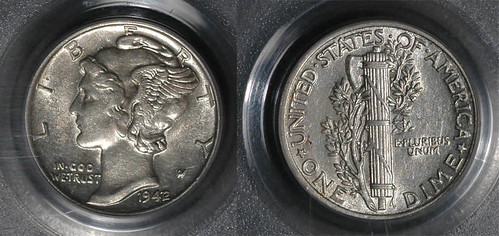
James Higby adds:
The Cherrypicker's Guide has an excellent treatise on doubled dies.
To read the earlier E-Sylum article, see: NUMISMATIC VOCABULARY: DOUBLED DIE VS DOUBLE DIE (www.coinbooks.org/esylum_v13n16a12.html)
WHO PASSED THE BBC NEWS NUMISMATIC QUIZ?
Ken Berger writes:
I got 6 out of 7; missed the last one.
Jim Duncan of New Zealand had a similar experience. He writes:
I got 6 - goofed on the last one. I scored seven out of seven on the remarkably-similar Coin News Quiz!
To read the earlier E-Sylum article, see: TAKE THE BBC NEWS NUMISMATIC QUIZ (www.coinbooks.org/esylum_v13n16a28.html)
NOTES FROM E-SYLUM READERS: APRIL 25, 2010
Regarding the "World's Greatest Book Collector" Haven O'More, Fred lake writes:
I'm sure that many of your readers who have also read Nicholas Basbanes's wonderful book A Gentle Madness will remember to change the punctuations found in Mr. Moore's name to read "Have No More". The tongue-in-cheek naming is a bit obscure, but it is all explained in Basbane's book. My copy is dog-eared from many re-readings.
Regarding numismatic articles in non-numismatic publications, Ginger Rapsus writes:
I recall an article in the Old Farmer's Almanac about the 1916 Liberty Standing quarter. This was the famous "topless" quarter, even though the Type I design was used in 1917 also! I submitted an article to the Almanac on the 1792 half disme, but they didn't want it.
Regarding Mrs. D. Dee DeNise, Tom Sheehan writes:
I believe that she was the ANA librarian for a time. I can't tell you much more, I never met her. I do recall her name being mentioned by older long gone collectors here in Seattle.
Joe Boling writes:
When I was in Seattle in the 70s, the O.P. Eklund collection was still being disseminated, and obtaining coins and tokens with his original envelopes accompanying them was possible and desirable.
Incidentally, if anyone has access to a decent photograph of Eklund, the American Numismatic Association needs it. He is a member of the Numismatic Hall of Fame, and the only photo that anyone has ever found is a small newspaper halftone that looks really ugly when blown up to plaque size.
To read the earlier E-Sylum article, see: QUERY: THE LIBRARY AND COLLECTION OF OLE P. EKLUND (www.coinbooks.org/esylum_v13n16a23.html)
Brent Zimmerman writes:
The article entitled "ALAN V. WEINBERG ON THE HOBBY IN THE 1960S" was a wonderful piece of history for me and many other readers, I would guess. As a relatively new collector (7 years) and numismatic student, Alan's words were a welcome refreshment in today's fast-paced drive-through world.
After reading and hearing stories from bygone years, and the great names from that time, I long for more. His own memories are priceless! I am still waiting to attend a "big" convention, such as an ANA or FUN event, and look forward to learning much, seeing more & making my own memories as well. Thank you Alan!
Tom Fort found an interesting piece of trivia, and I thought I'd share it in the form of a quiz. Who can complete this sentence? Double credit given to anyone who answers this without resorting to a web search.
Measuring in at roughly the size of a sheet of legal paper, the world's largest single banknote is ...
QUERY: PAPER MONEY REPAIRS
As a conservator, I have been approached by a small group of collectors who want some paper money repaired. I am not a collector myself but have the expertise to repair.
I wanted information on repairing paper money such as - technical details of paper /inks etc, for example the rag content of the paper used and what is considered by the collectors as an acceptable range of repairs to enhance and not devalue notes.
Having sought advice from the Bank of England we were directed to a very well-regarded historical society in UK. We were advised to purchase some books which would have all the information we require - we did this but they do not tell me the necessary. Do you have any articles that may have been published over the years to provide background information or perhaps technical accounts of repairs done??
I'd appreciate to hear the views of your members and to receive any information they may have regarding paper, inks (recipes even) , and general or specialist knowledge they may have acquired.
There is a lot of secrecy surrounding the matter of paper used. Understandable to prevent forgery but if repair is to be done to a note, (eg. to secure a ratty corner), then it is important to use a paper with a makeup content similar to the original. To this end one must approach the manufacturer, who, like the Bank of England itself, (I have been in touch with the Bank) understandably cannot give out information.
In general, regarding paper repairs, the less done the better and really paper repair is only necessary to prevent further deterioration or to secure a material that is disintegrating and would be lost to posterity otherwise.
The stresses and tensions in the fibres of the paper/ tissue and the properties of adhesive/ glue/ paste used are an important consideration and the same or similar paper with the grain going in the right direction are essential to have a good looking repair. Simple cleaning can often be done and without washing or ironing - it is just a matter of patience and time, more time, and being very gentle.
Whilst small tears and ripped notes can be (almost) invisibly mended, It is acceptable for a new paper repair to be noticeable as a repair although it is best if it can be of the same tone as the aged materials.
In many instances eg. older rare books, - a repair whilst enhancing the look and handling of a book can, in fact, often devalue the volume. The purpose of the repair/ restoration is to protect the text of the book. So, I would have thought the same thinking would apply to banknotes but it would be interesting to hear what others prefer to find acceptable and how the value of old money is affected by repair.
Information on actual repairs both good repairs and poorly done repairs, effected in the past are always very helpful to provide background and awareness of problems that other people have had.
THE BOOK BAZARRE
THE 2010 BROOKGREEN GARDENS MEMBERSHIP MEDAL
Richard Jewell writes:
I attended the Annual President's Council Reception last Sunday, April 18th at Brookgreen Gardens. The event was held at the Fountain of the Muses in the bright afternoon sun at Murrells Inlet, South Carolina. I thought this membership medal and its history might prove interesting to your readers.
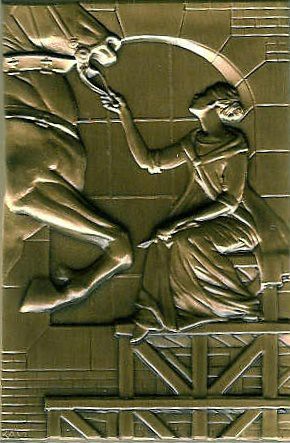

The 2010 Brookgreen medal, The Calling of the Sculptor by Amy Kann, depicts artistic creation as the sculptor's higher calling. Ms Kann explains: "We aren't free to choose another profession because we are called to this one, much like a priest is called to the priesthood." The obverse depicts a scene from 1910 as Anna Vaugh Hyatt works in the studio on her early triumph in sculpture, the equestrian Joan of Arc.
For more information about Brookgreen Gardens, see: www.brookgreen.org
For more information on this medal and the series, see the images of the program Rich Jewell scanned for us on Flickr:
www.flickr.com/photos/coinbooks/4546277303/sizes/l/
www.flickr.com/photos/coinbooks/4546910576/sizes/l/
THE BOOK BAZARRE
THE HOWARD BOWKER CHINESE COIN COLLECTION
Max Spiegel writes:
This is an interesting story from NPR about a Chinese coin collection being donated to the Shanghai Mint by an American family. I thought it might be of interest to E-Sylum readers.
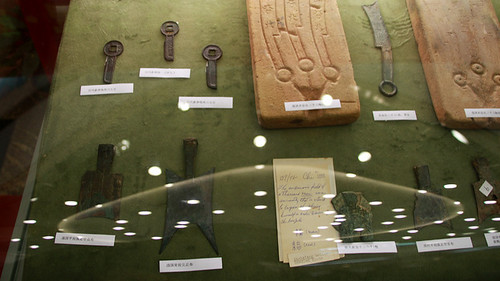
In China, paramilitary police drill outside the Shanghai Mint. They're stationed there because it's literally a moneymaking plant.
It's also a museum and, on Friday, it received a new, welcome donation, hand-carried from the U.S. with far less security.
Gordon Bowker is one of the founders of Starbucks, although he no longer has any relationship with the company. He and his cousin Carolyn Bowker packed up part of their grandfather's priceless coin collection in their luggage, brought it to China and donated it to the Shanghai Mint Museum.
"There really is no better place for the coins to be," says Gordon Bowker. "They would have much less interest to scholars and to the public anywhere else in the world. So it's a natural thing for them to be in Shanghai where they originated."
Gordon and Carolyn Bowker's grandfather Howard Bowker joined the U.S. Navy when he was 19 years old and was stationed in Hankou, China, in 1923. He taught himself Chinese, Japanese and Korean. He also began collecting coins, a hobby that Gordon Bowker says married two of his grandfather's greatest passions.
"He was fascinated by Chinese history. And he had a big background in money: He was a purser, and a paymaster, and he liked money. I think he liked to count it," Bowker says.
The resulting coin collection reflects the past 2,000 years of Chinese history. Its earliest piece is a coin mold dating back to 200 B.C., during the reign of China's unifier and first emperor, Qin Shihuang.
Michael Chou from the iAsure Group, which runs an auction house specializing in Asian coins, has been researching the collection for two years. He describes how the coin mold produces multiple coins.
"They pour very hot metal into this mold and then a coin tree comes out of this coin mold, and then they break off the coins from the tree individually. So when someone tells you money doesn't grow on trees, it actually does in China," Chou says.
Chou says it's impossible to value much of the collection, since the objects are so rare, they seldom are sold on the open market. He says items such as the 2,000-year-old coin mold would be considered a "national treasure" in China.
Every coin in the collection is a tangible slice of China's history. One item with immense historical significance is a copper dollar featuring a sailing junk over three flying birds on one side and Sun Yat-sen on the other.
 When it was issued in 1932, the
Sun Yat-sen dollar was the first national coinage for the whole of China; until that point, coins had been issued regionally.
When it was issued in 1932, the
Sun Yat-sen dollar was the first national coinage for the whole of China; until that point, coins had been issued regionally.
It's a testament to the chaos of China's recent history -- and the flow of valuables beyond its borders -- that the Shanghai Mint Museum didn't have a single example of this historic coin, which was designed in the U.S. by the Philadelphia Mint.
Zhang Yueqin is deputy general secretary of the Shanghai Mint's Coin Institute. When asked about the significance of this coin, his voice thickens and he becomes visibly emotional.
"We had the mold, but we didn't have a coin," he explains. "The coin has finally come home. It's as if after 80 years a mother is reunited with her child. It's a miracle. The friendship between China and America is embodied in this coin."
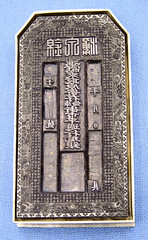 The bequest, including a library, was originally left to the
Smithsonian, where Howard Bowker had worked as a curator. But his descendants decided the collection would be better served -- and more accessible -- elsewhere.
The bequest, including a library, was originally left to the
Smithsonian, where Howard Bowker had worked as a curator. But his descendants decided the collection would be better served -- and more accessible -- elsewhere.
"There's no curator of Asian coins at the Smithsonian," Gordon Bowker explains. "Without the staff and the ability to display the coins, it would display much less interest in having that collection."
The restitution of valuables to their point of origin is an increasing trend, although in this case, the coins were bought legitimately, not looted.
The Smithsonian's loss is Shanghai's gain, although I wondered how the family managed to override Bowker's will, and diss the more-than-able staff of the National Numismatic Collection. I asked NNC curator Richard Doty, and apparently it was offered to the museum, but when it came before the Collections Committee someone thought "it wasn't 'American' enough."
The Shanghai Mint does seem like a very appropriate and appreciative home for the collection, however. Another stop for globetrotting numisma-tourists. -Editor
To read the complete article, see: Priceless Coin Collection Returns Home To China (www.npr.org/templates/story/story.php?storyId=126050356)
NEW 2011 $100 BILL DESIGN UNVEILED
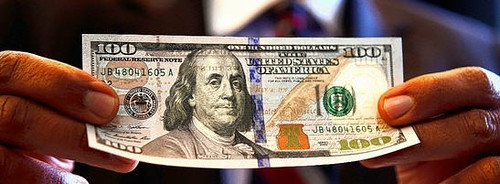
The Treasury Department unveiled what it calls "the next generation one hundred," a redesigned $100 bank note to stay ahead of counterfeiters. The new $100 notes will be available on Feb.10, 2011.
The familiar portrait of Benjamin Franklin remains in the usual spot. But a historical reference to the quill used by the Founding Fathers appears superimposed over phrases of the Declaration of Independence and a 3-D security ribbon crossing the center capture attention. The images on the ribbon move as the bill is tilted. It's all designed to thwart attempted fakes.
By now, the government has become intimately familiar with the process of rolling out new money. Over the past decade, the $20, $50, $10 and $5 have all received makeovers.
The new look puts the finishing touches on what the government calls its second major redesign. The $100 bill last got a makeover in March 1996.
As a rule of thumb, the Treasury redesigns currency every seven to 10 years because advancements in technology have made counterfeiting outside the norm of professional criminals possible.
The name of the game is to make notes that are hard to counterfeit but easy for the public to authenticate.
In 1996, when the $100 currency was last redesigned, it got a portrait watermark, an embedded security thread and color-shifting numeral 100. This time around two of the most prominent features the public will notice right away are a 3-D security ribbon woven into the paper and a bell in an inkwell.
The 3-D security ribbon contains images of bells that transform to numeral 100s that turn into images of bells, and back again, as the note is moved. When the note is tilted back and forth, some images on the ribbon appear to move side to side. If the note is shifted side to side, these images slide up or down.
What's at work is a new security technology called Motion that was developed by Visual Physics, a subsidiary of Nanoventions, based in Atlanta and acquired by Crane & Co., the manufacturer of U.S. currency paper based in Dalton, Mass. Sweden's 1,000-kroner banknote was first to use this technology. Crane & Co. wouldn't comment for this article.
As for the bell-in-an-inkwell feature, when the note is laid flat on a table, only a solid copper inkwell is visible. When the note is moved, the inkwell changes color from copper to green. The movement will also make a Liberty Bell appear.
In addition, the reverse of the $100 note will now show the back instead of the front of Independence Hall in Philadelphia.
The changes will increase the government's cost of making a single $100 note to 11.8 cents per note from 8 cents per note. The average $100 bill lasts between seven and eight years.
To read the complete article, see: Money Makeover: $100 Bill Gets Facelift to Fight Fakes (online.wsj.com/article/SB10001424052748704133804575197990310606472.html)
MONEY MAKEOVERS: ARE THE DEAD PRESIDENTS GETTING YOUNGER?
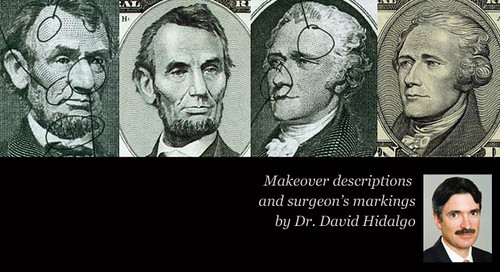
There are two elements of a redesign. One is the introduction of new security features, like watermarks and hidden text (hold any new bill up to the light and you'll see them). The government lists many of the features on its Web site, but the more advanced components are never publicized, for obvious reasons. The other element of the redesign is aesthetic. "Two thirds of American money circulates outside the U.S., so it has to look uniquely American," says BEP Director Larry Felix. As for the larger and easier-to-read numbers on more current bills, you can thank "an aging population," he says.
But that's not all. NEWSWEEK has noticed something more subtle, something that would appear to be so indelible in American lore that it couldn't possibly change over time: the styling of the portraits, which appear to have been altered in a strange way. Over time, America's iconic forefathers come off looking good, even better than they used to—and it's not just some airbrushing and smoothing out. Put simply, if the Founders and their notable descendants lived in modern times, they might find themselves on magazine covers beside words like "nip and tuck."
Dr. David Hidalgo, a plastic surgeon in New York, compared the images of the presidents (and Ben Franklin and Alexander Hamilton) on past and current bills, pointing out just what kinds of procedures currency designers might have performed on our presidents had they been cosmetic surgeons. The most obvious: Alexander Hamilton, who might be surprised to hear he's undergone eyelid surgery to remove bags under his eyes and a "full-face laser peel" to smooth his complexion.
Then there's Abe Lincoln, pictured several months after a nose job to heighten his masculine look, plus small cheek implants, which, Hidalgo notes, "he did not need." Civil War Gen. Ulysses Grant, keeper of the $50 note, has had an apparent Botox injection to "soften the angry look between the eyes and lower forehead." In the latest portrayal of Franklin, it appears that his neck has been visibly tightened and several wrinkles have been removed around his right eye.
It might be more humorous than offensive, but straight-faced BEP officials deny that touch-ups are part of the design process. "If there are [cosmetic changes], they were unconscious," says Felix when shown side-by-side images of the different portraits. But "if we're talking about the authority of U.S. icons conveyed in these images, I suppose it's possible," he adds, referring to slight improvements in appearance. He notes with each redesign, the iconic images are interpreted by different artists.
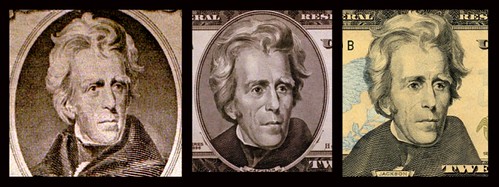
'President Jackson has been treated with injectables to fill in his temple hollows and laugh lines (nasolabial folds). His lower-eyelid fat bags have been removed to make him less tired-looking, but he has acquired an overall 'surgical look' in the process. Together with the hair styling and blow-dry (does he still have a stylist's apron on?) he looks a bit less masculine than before.'

'President Lincoln has been treated to a full-face laser peel that has removed all blemishes and has rejuvenated his sun-damaged skin [this is the effect of a softer engraving technique with no dotted lines]. He has been treated to a haircut and an expert dye job that leaves only a few wisps of distinguished gray color. His beard has been trimmed to give him a less disheveled look.
His eyebrows have been waxed to remove errant hairs. He has gotten small cheek implants that he did not need (it would have been better to fill in his hollow cheeks with fat or injectables). His nasolabial folds are a bit softer, suggesting the addition of injectable fillers. Surgically, he has been treated to a subtle rhinoplasty that retains a masculine look. The nose is straightened and the aged, drooping tip raised. He has had his lower-eyelid bags surgically removed, effectively eliminating a tired look.'
To read the complete article, see: Million-Dollar Men (www.newsweek.com/id/236732)
ROBERT LEUVER ON THE ANA ROSEMONT CONVENTION SITE
You have probably run amok on the issue of Rosemont vs downtown Chicago as the ANA Convention site. However, I am happy that David Lange raised the issue as I am certain the issue has perplexed many.
Rosemont was our choice for the 100th ANA anniversary convention with John Wilson as general chair. It was a thrilling success - some 20,000 numismatists attended. The Chicago Coin Club did a tremendous job promoting and staging the show and backing up John and Ruthann Brettell.
I moved back to the Chicago area 2 1/2 years ago and now live in Tinley Park, a far, southwest suburb, after almost 40 years. Talking last year with Bob Leonard, I learned he commuted from a far-north suburb to Tinley Park on a daily basis--this must have been an hour's commute. If Bob had driven through Chicago, that would have been at least two hours each way. The route Bob took is the sterling advantage of Rosemont, an easier commute.
Rosemont offers the following for conventions:
- Rosemont is safer than Chicago!
- Air transportation and coin baggage. A mere 10 minutes from O'Hare and probably 45 minutes from Midway. Hotels provide transport. Advantage dealers!
- Conventioneers by car. An easy commute from Indiana, Chicago, Milwaukee and the Chicago suburbs, principally by I-294, the Tri-State. I-294 recently accomplished a complete restructuring.
- Restaurants: Every well-known Chicago and national chain has a site either in Rosemont or ten minutes north.
- Cost of transportation. The "L" with the first stop east of O'Hare, will speed someone downtown (The Loop). Taxis are relatively cheap.
- Hotels. Rosemont, as an attractive convention site, has all major hotels with complimentary transport to the airport, convention center and restaurants.
- Parking. All I'll say is, you do not want to park downtown or near downtown in Chicago. It will cost more than $25 for four hours plus.
- More reasonable costs as a convention site. McCormick place has prohibitive costs. McC Place has lost three major conventions in the past six months to Orlando and Las Vegas due to the cost of staging a convention. This is important to ANA.
I would counsel Bob Leonard to stage a trip to Great America for families during the convention - perhaps only a half-hour trip. Also, as Ruthann did, take in a night game at Wrigley Field or Comiskey Park--ok, you can see I have been away from Chicago too long--Cellular Field now.
Enjoy ANA's World Fair of Money (a Steve Bobbitt sobriquet) for ANA's summer convention. Look forward to Rosemont and the ANA. Bob Leonard and company will do a great job.
To read the earlier E-Sylum article, see: ON THE CHOICE OF ANA CONVENTION CITIES (www.coinbooks.org/esylum_v13n16a25.html)
JOE BOLING ON THE ANS COUNTERFEIT MONEY EXHIBIT
Until the advent of the computer and ink-jet printers, counterfeit notes were made with engraved plates on offset printing machines.
"Until the advent of the computer and ink-jet printers, counterfeit notes were made with engraved plates on offset printing machines." Is that what the ANS press release actually said? Engraved plates and offset printing machines don't go together. Tell me they really didn't say so.

Bleached $100 note with fake watermark
IMAGE COPYRIGHT UNITED STATES SECRET SERVICE (USSS).
And the caption "Bleached $100 note with fake watermark" is incorrect, too. The whole purpose of bleaching banknote paper is to obtain a piece of paper that already has a genuine watermark in it - you don't need to insert another one. The Bureau changed the $5 note so that it would no longer bear a portrait watermark. If you are going to laminate a fake watermark into a note, you start with lightweight plain paper. Making it defeat the ubiquitous marker pens is not a problem.
Even if you don't want an accompanied tour of the exhibit, you have to let them know in advance that you are coming. According to Coin World, that's three days in advance - so the New York Fed can run your name against the no-fly lists and other security databases. To read the earlier article, see: ANS OPENS NEW EXHIBIT ON COUNTERFEIT MONEY (www.coinbooks.org/esylum_v13n16a08.html)
ON JANVIER REDUCING MACHINES
Last week I received this email from John Scungio of Providence, Rhode Island:
I read your article about the Janvier reducing machines. I am liquidating my family business, Angelo DiMaria Inc.(est 1928). We have a nice machine that I don't know how to market.
I suggested starting with an E-Sylum ad, which appears elsewhere in this issue. I wrote:
If anyone would know about and be interested in a Janvier machine, it would be one of my readers or one of their friends.
John adds:
We made jewelry parts, shoe ornaments, western saddle ornaments, military insignia and police badges. We did the die cutting, hubbing and pantographing for our metal stamping shop. At the high water mark (around 1989-'90) we had 50 employees.
Here are some of the earlier E-Sylum articles discussing these machines.
THE JANVIER DIE-ENGRAVING PANTOGRAPH (www.coinbooks.org/esylum_v07n11a10.html)
MORE ON THE U.S. MINT PANTOGRAPHIC REDUCING MACHINE (www.coinbooks.org/esylum_v09n01a05.html)
THE BOOK BAZARRE
EGYPT FINDS HOARD OF 2,000-YEAR-OLD BRONZE COINS

Archaeologists unearthed 383 bronze coins dating back to King Ptolemy III who ruled Egypt in the 3rd century B.C. and was an ancestor of the famed Cleopatra, the Egyptian antiquities authority announced Thursday.
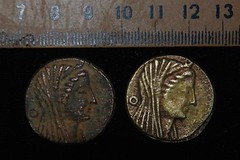 The statement said one side of the
coins were inscribed with hybrid Greek-Egyptian god Amun-Zeus, while the other side showed an eagle and the words Ptolemy and king in Greek.
The statement said one side of the
coins were inscribed with hybrid Greek-Egyptian god Amun-Zeus, while the other side showed an eagle and the words Ptolemy and king in Greek.
Founded by one of Alexander the Great's generals, the Ptolemaic Dynasty ruled Egypt for some 300 years, fusing Greek and ancient Egyptian cultures.
The coins were found north of Qarun lake in Fayoum Oasis 50 miles (80 kilometers) southwest of Cairo.
Other artifacts were unearthed in the area included three necklaces made of ostrich egg shell dated back to the 4th millennium B.C. and a pot of kohl eyeliner from the Ottoman Empire.
The objects will all be displayed in the new Egyptian museum under construction near the pyramids of Giza.
To read the complete article, see: Egypt Finds Hoard of 2,000-Year-Old Bronze Coins (www.artdaily.org/index.asp?int_sec=2&int_new=37611)
See also: Egypt dig uncovers coins more than 2,250 years old (www.physorg.com/news191164142.html)
VICTORIA CROSS MEDAL SELLS FOR A RECORD £252,000
 The first Victoria Cross ever
awarded to a British Army soldier sold for a staggering £252,000 at auction yesterday - more than twice its estimate. Lord Ashcroft an avid collector of VCs was outbid by an
anonymous buyer, to the disappointment of the family of Major John Simpson Knox, who won the honour.
The first Victoria Cross ever
awarded to a British Army soldier sold for a staggering £252,000 at auction yesterday - more than twice its estimate. Lord Ashcroft an avid collector of VCs was outbid by an
anonymous buyer, to the disappointment of the family of Major John Simpson Knox, who won the honour.
The lot, which included three other medals, two portraits, a cap badge and a belt plate sold for £252,000 at Spink Auction House in London.
It had been estimated to fetch around £120,000. Major Knox, of the Scots Fusilier Guards, was awarded the VC for his gallantry while fighting in the Crimean War between 1854 and 1855.
The medal, the highest military award for valour, went under the hammer in London along with a cannonball reputed to have blown the Glasgow soldier's arm off.
But descendants of the war hero had wanted the VC to go on permanent display with the rest of Major Knox's collection at the Imperial War Museum.
Michael Naxton, curator of the Ashcroft Collection, said the Tory peer had hoped to buy it after the family had written to him opposing the sale. 'But although Lord Ashcroft is a man of means there has to be some consideration of commercial realities,' Mr Naxton told The Times.
To read the complete article, see: (www.dailymail.co.uk/news/article-1268224/First-Victoria-Cross-fetches-250-000-auction.html)
MAN ARRESTED IN ENGLAND FOR USING NORTHERN IRISH BANKNOTE
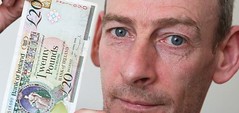 A shopper was arrested after trying to
use a Northern Irish banknote at an English branch of Tesco.
A shopper was arrested after trying to
use a Northern Irish banknote at an English branch of Tesco.
Peter Byrne was handcuffed by police officers and put into a squad car after refusing to leave the store without the items he wanted to buy.
He says staff told him that Tesco did not accept Irish banknotes.
Workers at the shop had telephoned police after the 43-year-old allegedly became abusive.
However, Mr Byrne - who had tried to pay for £11.14 of goods with a Northern Irish £20 note - claims that he 'remained calm' throughout.
'I was stunned because I had used a similar note in the same shop the night before and there hadn't been a problem,' said Irish-born Mr Byrne.
'I work three days a week in Ireland and often bring back notes. I tried to explain it was sterling.'
Police released Mr Byrne without charge after the incident at the Tesco Express store in Bournemouth and drove him home.
A Tesco spokesman said its employees have the right to refuse any note but there was no policy to reject Northern Irish banknotes.
'In Bournemouth they don't normally see them and there were suspicions the note was a fake,' he added.
To read the complete article, see: Man arrested for paying with Northern Irish £20 banknote (www.metro.co.uk/news/822952-man-arrested-for-paying-with-northern-irish-20-banknote)
FEATURED WEB SITE: AMERICAN MEDALLIC SCULPTURE ASSOCIATION
This week's Featured Web Site is the American Medallic Sculpture Association (AMSA).


The purpose of the American Medallic Sculpture Association (AMSA) is to encourage the creation and study of medallic sculpture in North America. All who are interested are welcome as members. Our aim is to disseminate information and add impetus in making medallic sculpture a vital and viable art form in this country.
Since its founding in 1982, AMSA has sponsored a series of programs to encourage the development of medallic art in the United States and Canada and provided opportunities for communication among artists, commissioners, producers, collectors and scholars of the medal.
www.amsamedals.org
